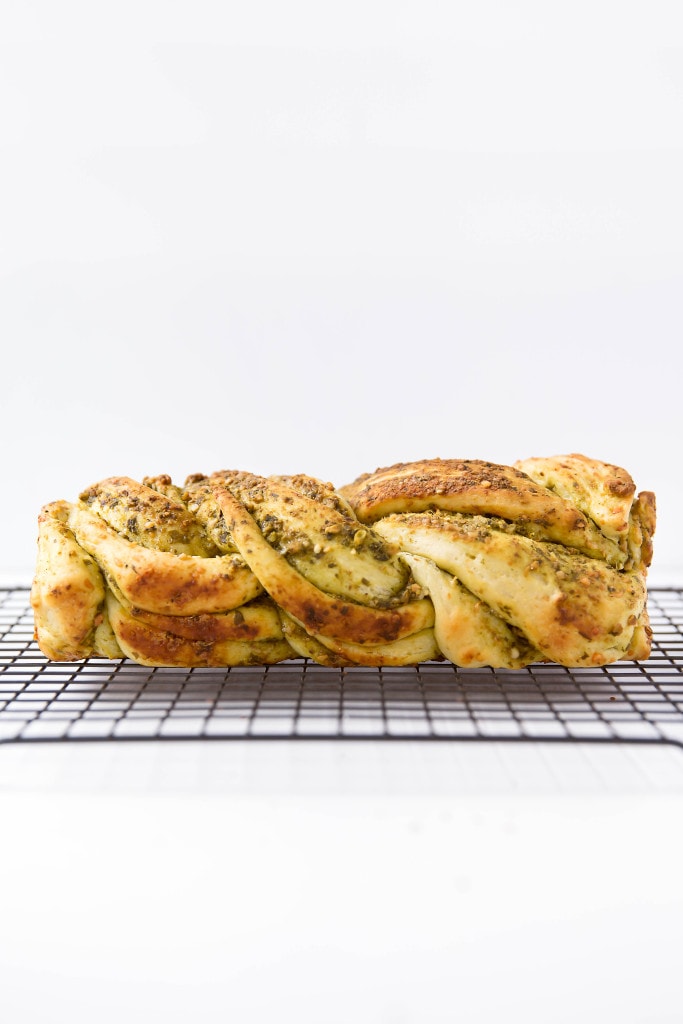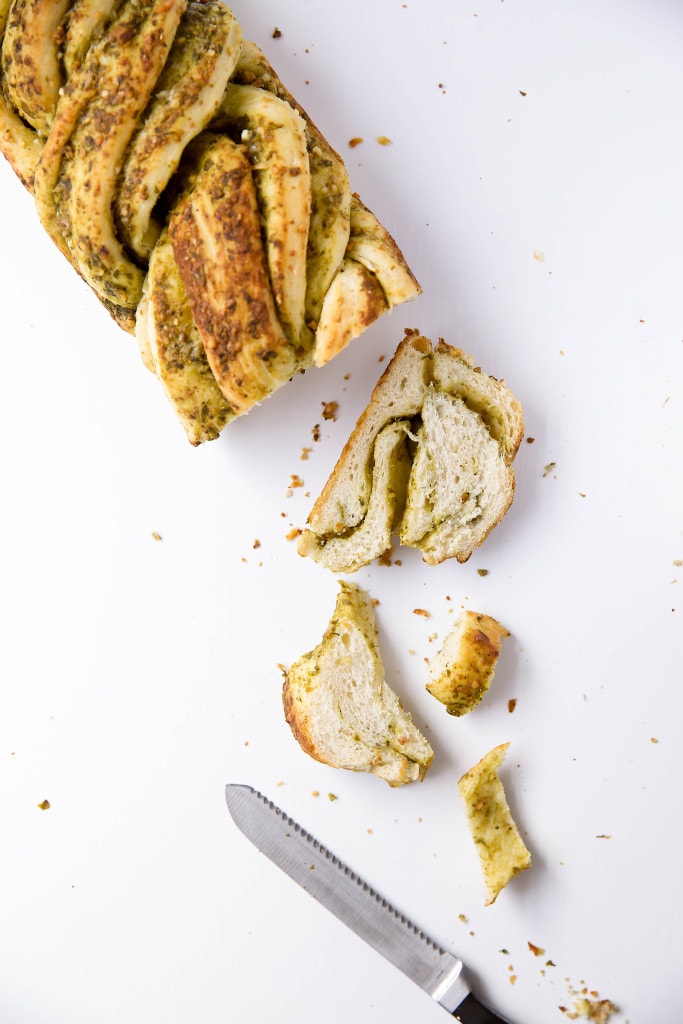- Recipe Index
- Savory
- Parmesan Pesto Bread
Parmesan Pesto Bread
This website uses affiliate links which may earn commission for purchases made at no additional cost to you.
Of a few things I am certain:
1) I am taking enzyme pills and they make me super nauseous
2) All I want to eat is carbs, because they’re easy on my stomach
3) As a result, I ate close to 1/2 of one of these loaves
So you see, my judgement may be slightly impaired. I’m a carb-o-holic right now. But this loaf is EVERYTHING.
I’ve always been a pesto fan. It’s just perfect—loads of basil ground with pine nuts and olive oil. It’s umami and fragrant and fresh and rich all at the same time. So when my sister, who works at a farm, brought home the biggest basil bunch I’ve ever seen (the leaves were the size of maple leaves!), I knew just what to do.
And it’s also because I have had bread on the brain for the last, oh, three weeks.
This loaf is perfect for a late summer dinner. It combines that herbaceous taste that is so summery with a light and artistic bread. Oh, and there’s a boatload of parm involved. I mean, nothing can go wrong when parm is involved. In fact, it makes everything right.
How to make parmesan pesto bread
Don’t let the beautiful swirls of pesto fool you into thinking this bread recipe is tough to make—far from it! To make this parmesan pesto bread, you first need to activate the yeast. Combine the buttermilk, water, and sugar in a bowl and microwave until warm but not hot (if it’s too hot, you’ll kill the yeast). Add the yeast and let the mixture sit on your countertop for 5-10 minutes, or until it goes foamy. This means the yeast is active and your bread will rise!
Stir the oil, egg, and salt into the yeast mixture, then add everything to a stand mixer. Turn the mixer on at a low speed, then add in the flour one cup at a time. You’ll need to let the dough knead for a good 10 minutes. You’ll know when it’s been properly kneaded when it holds its shape in a ball, but is still slightly sticky to the touch. Put the dough into a greased bowl, cover with plastic wrap, and let it chillax in a warm space for about an hour (it should double in size).
While the bread is rising, make the pesto. To make homemade pesto, throw all the ingredients into a food processor and whizz everything up until a sauce forms. If you don’t have pine nuts on hand, walnuts or almonds will also work (pine nuts have a much stronger flavor though, so definitely use them if possible!).
Next comes the more technical part of this pesto bread recipe: rolling and shaping the dough. I’ve explained the steps in detail in the recipe below, but essentially what you have to do is roll out the dough into a massive rectangle, spread the pesto over it, roll it up into a log, and then twist the log over itself, making sure that the seam is always facing up (this will keep the pesto inside the bread and will prevent it from leaking out).
Cut the massive twist in half, and lay each twisted loaf into the prepared bread pans. You’ll then need to let the bread rise for another 45 minutes before baking it.
Hope you all have fantastic weekends. If you need to reach me, I’ll be hanging with this parmesan pesto bread.
Print
- Yield: 2 loaves
Parmesan Pesto Bread
- Yield: 2 loaves
Ingredients
For the bread
- 1/3 cup buttermilk
- 2/3 cup water
- 1 tablespoon sugar
- 1 package (2 1/4 teaspoons) instant active yeast
- 3 tablespoons olive oil
- 1 large egg, room temp
- 1/2 teaspoon salt
- 3 1/4 cups flour
For the pesto
- 2 cups basil leaves
- 1/4 cup olive oil
- 1/2 teaspoon salt
- 2 teaspoons lemon juice
- 2 tablespoons pine nuts
- 1 cup grated parmesan
Instructions
- In a small bowl, microwave the milk, water, and sugar for 45 seconds, until it is warm but not hot. Add in yeast and stir. Allow to sit for 5 minutes. The mixture should foam, signaling that the yeast is active. Then, stir in oil, egg, and salt.
- Pour mixture into a standing mixer fitted with a dough hook. Turn the mixer to low speed and slowly add the flour 1 cup at a time. Let the dough knead for 5-10 minutes. Dough should be smooth and slightly sticky but firm enough to hold together in a ball.
- Coat a large bowl with oil and place the dough into the bowl. Cover with plastic wrap and set in a warm area to proof for 1 hour or until the dough has doubled in size.
- While dough is proofing, make your pesto. In a food processor, combine all ingredients except parmesan, pulsing until they come together. Set aside.
- Line two bread pans with parchment paper. Set aside.
- Flour a large work surface. Roll the dough out into a 12 inch by 20 inch rectangle. Smear the pesto over the dough, coating it evenly. Sprinkle the parmesan on top.
- Roll the dough into a log (so the log is 20″ long). Using a serrated knife, cut the dough in half lengthwise (you will end up with two very long half cylinders). Carefully fold one half-cylinder over the other, keeping the cut side face up, the repeat with the other side, forming a long twist.
- Cut the twist in half so you have two 10″ twists. Carefully place each twist into the lined bread pans, then loosely cover with plastic wrap or a kitchen towel. Allow dough to rise a second time in a warm place for 45 minutes.
- Preheat the oven to 375°F. Bake for approximately 35 minutes, until the top is nicely golden brown. You’ll want a deep golden color, as the outside of the loaf can be cooked and the inside still doughy. Use your discretion.







One of the best bread recipes I’ve ever made! I feel like the instructions for the braiding and construction of the loaf could have been more clear, I imagine it would be a little difficult to follow for some first-time bakers. I loved the flavours and will definitely be making again!!
[…] Parmesan Pesto Bread from Broma Bakery […]
Sarah,
I’m making this and I am wondering about a couple of things:
I assume that I not only keep the two long edges apart, but that I create a long 20″ twist that I then cut into two 10″ twists?
Is a bread pan the same as a loaf pan? Or do you mean like a cookie sheet? Thanks if you read this!
Hi Cathy! A bread pan is the same as a loaf pan! And yes, you will create a 20″ twist that you cut into two 10″ twists!
Thanks & happy baking!